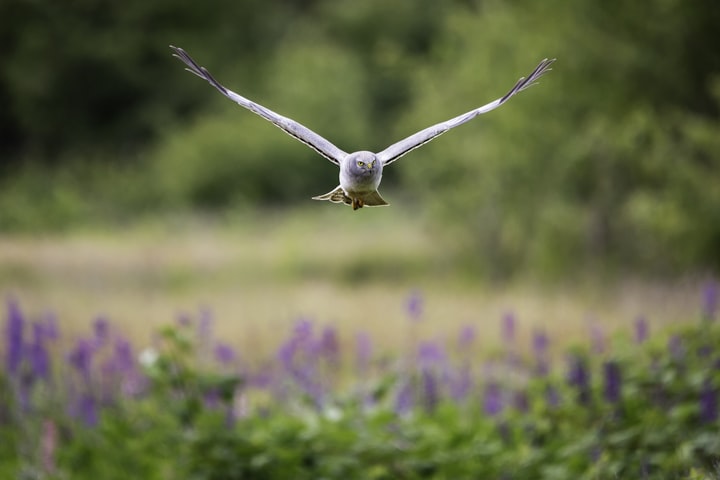I leap from a hedge to escape the nettles, arms held aloft like a poorly-controlled marionette, and manage to scare away every single living thing for fifty yards, apart from the grass.
I had walked here in search of something special – an eye-wateringly rare raptor – along an old turnpike that crossed the Wiltshire downs and, yard-by-yard, the road had narrowed to nothing. Where once a broad verge allowed cattle to graze, herded along at a shilling a score, the road was now a byway open to only the determined, a wheel rut at the centre of a thicket.

Progress had slowed, the hedges on each side had knitted together and the foliage thickened so much that a willow warbler – a leaf of a bird singing loud and clear a yard or two away – was indistinguishable from the greenery. Unpleasantly hot and with the air thick with chlorophyll and pollen, I sneezed my way into a kind of delirium.
A shaft of sunlight pierced the hedge, a finger of God that – and I can’t help feeling a little disappointed here – chose to spotlight a public footpath sign. Unhelpfully, the sign appeared to point into a bush and a wall of nettles, though there was an open path beyond. It was here that I made my spectacular entrance.
Six years ago, on this windy Wiltshire hill-top farm, Britain’s rarest raptor – the Montagu’s harrier – made its own spectacular entrance and left a lasting impression on me. This particular Monty flew her low and deliberate tern-like bobbing flight, rowing against the wind, rolling and yawing with every tiny bump and hollow of air towards the farm shop café. Her disappearance ten seconds later behind a barn was the cue for a long, fruitless search of the area that left both her exact identity unproven and my cream tea as cold as a stone.

The Monty is so rare, my sighting of it plunged me into a world of secrecy, a find I could only share with an RSPB hotline and my family. While twitchers gush about hapless stray warblers from Europe or wind-blown trans-Atlantic sandpipers to anyone who will listen, they are much more reserved when it comes to a Montagu’s harrier; it is a special case, a regular, but scarce summer visitor and an even more occasional breeder at the very northern limit of its range. It is also a species under duress on the route of its migration from sub-Saharan Africa – particularly over trigger-happy Malta in the hunting season, a phenomenon so brutal it moved the naturalist Chris Packham to declare it an avian apocalypse.
Of the few that manage to make it to England, a sample of Montys manage to breed – to the delight of the organisations involved – on North Norfolk’s nature reserves, but the Montagu’s harrier is otherwise spread across southern England in virtually homeopathic concentrations; between 6 and 12 pairs, they are everywhere and nowhere. An email back from the RSPB cautiously agreed that my description of the bird sounded as if it could, indeed, be here as well.

Swifts scream high as swallows quarter the field of ripe wheat that lies between the hedge and the farm. Golden and bowed, every head the same height, it creates an impression of perfect velveteen, a sumptuous summer duvet with an iridescent sheen of green shimmering in the heat haze. If my Monty was nesting, it could be somewhere in that field, or the next one – their ranges are relatively compact.
I scan the winter wheat and the fence posts for what sometimes seem like two totally different species. Male Montys are battleship grey with a white belly and black wingtips, the females are the standard mottled brown of many raptor females but with a prominent white rump. The difference between the sexes is marked, a trait it shares with its close, almost identical relative, the much-persecuted Northern or hen harrier. Until 1802, naturalists thought the grey males of Monty and Northern were the male and female of one species, while the brown females were the two sexes of another bird entirely, a hawk they called the ‘ringtail’. It took the naturalist Colonel George Montagu to untangle the do-si-do and sort out the domestic arrangements. Monty is named in his honour, while ‘ringtail’ persists as birders’ vernacular for the juveniles and females of both species.
A chat with a pair of lads in the farm shop, yields a few quiet shrugs from one, and an apologetic disclaimer from the other: “I don’t really know anything about birds”, he tells me. But I am sure that he has seen something and tease out a description of a “large bird of prey, that flies low over the fields, over there.” He points at a substantial patch of tall grass at the edge of a recently cut field of stubble. My suspicions are aroused by this untidy patch of four-and-a-half foot high grass and weed and I wonder whether my informant’s taciturn friend is not regarding me with standard-issue bemusement at all, but outright suspicion. My informant adds that he presumes the bird in question is a buzzard, “but, as I said, I don’t know much about birds”.
A Monty is a little smaller than a buzzard and is streamlined and lighter, all of which makes their flight seem as effortless and buoyant as a gull. While buzzards soar, I tell him, the bird I was looking for flies low and quarters the field for rodents and small birds, holding their wings in a shallow V. This seems to pique his interest, or he just might be trying his best to be polite.

An awkward silence at the counter forces me into an order for tea and scones. Maybe he knows, the RSPB knows and all are sworn to secrecy. The trail of Monty has suddenly gone as cold as an abandoned scone.
About the Creator
Ian Vince
Erstwhile non-fiction author, ghost & freelance writer for others, finally submitting work that floats my own boat, does my own thing. I'll deal with it if you can.







Comments
There are no comments for this story
Be the first to respond and start the conversation.